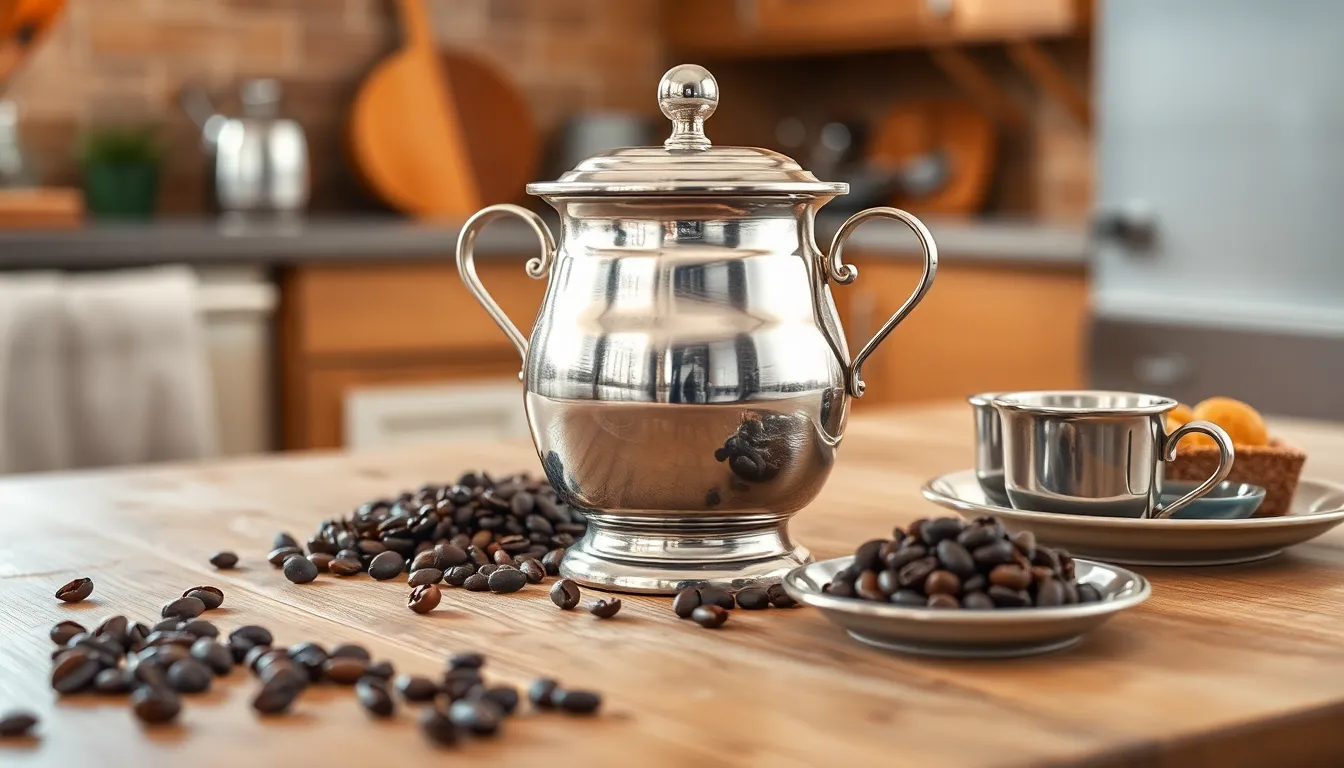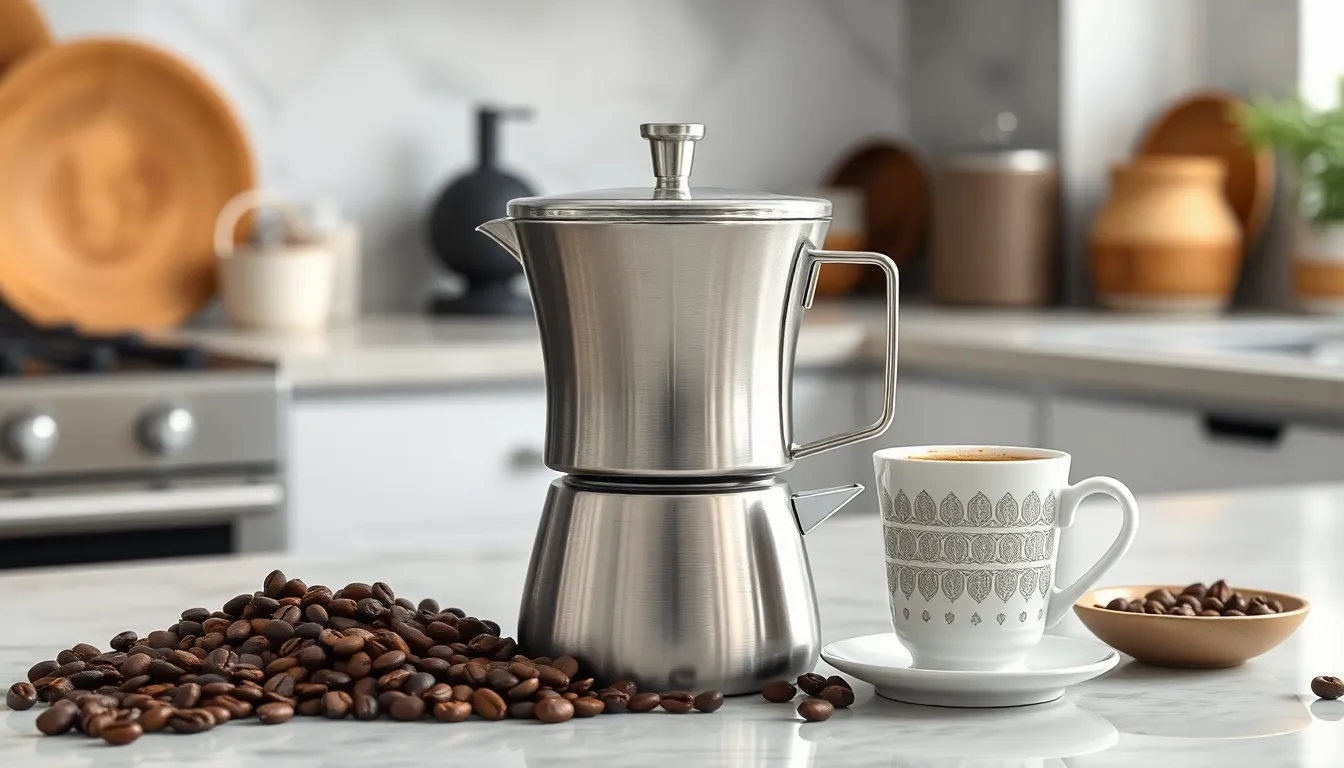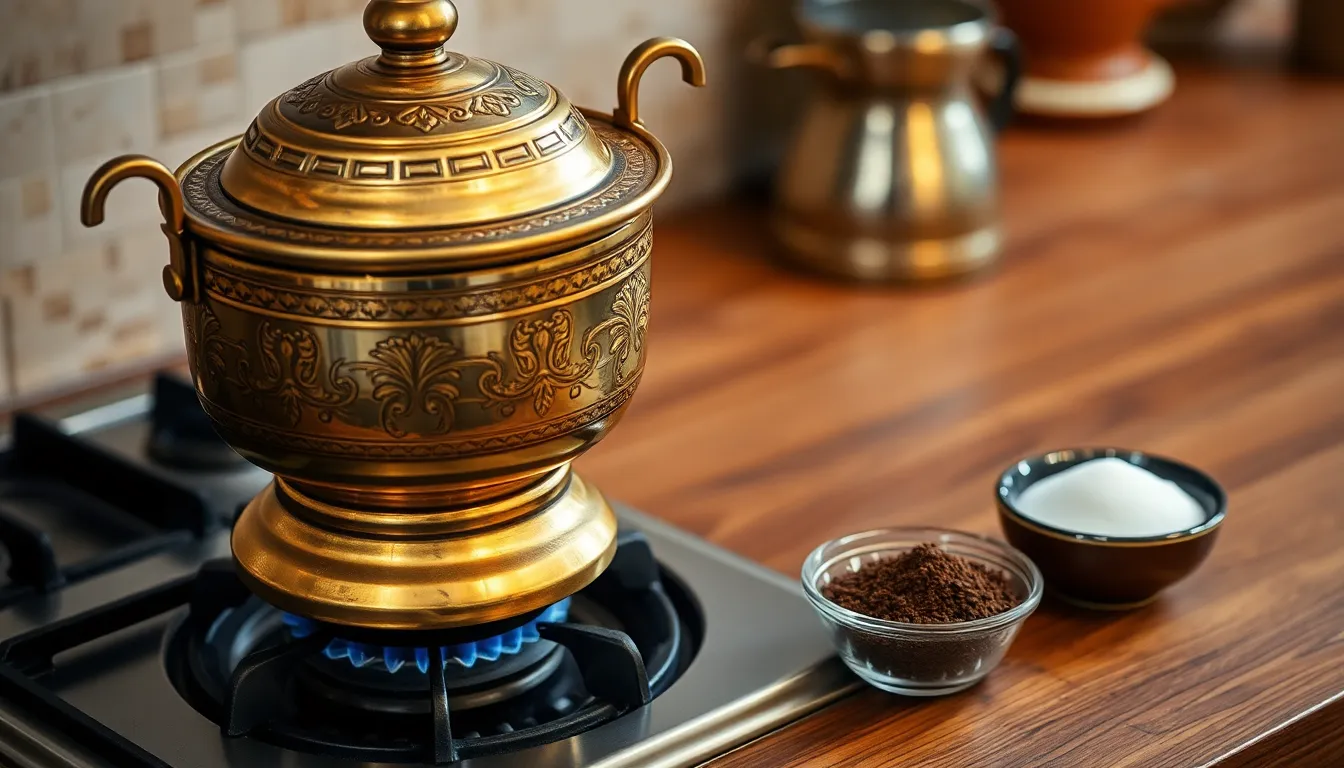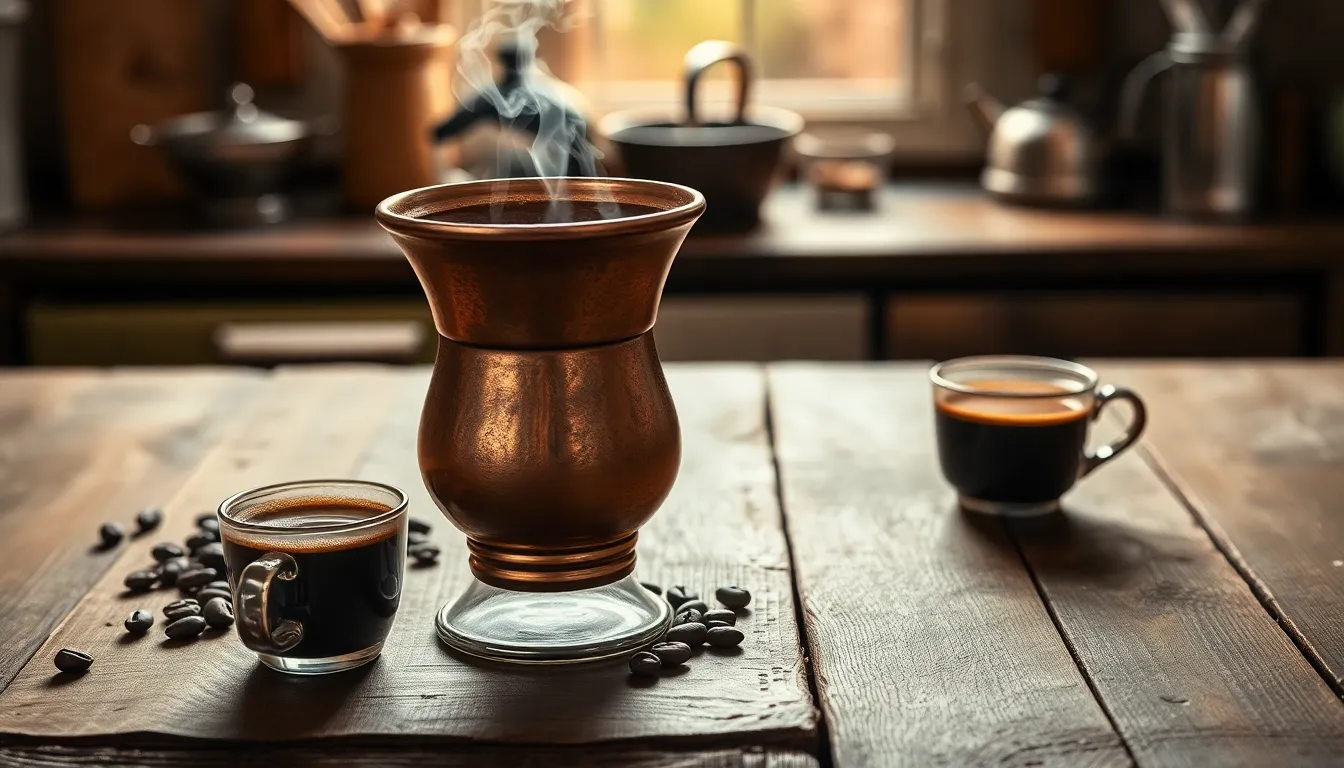Have you ever wondered what a cezve is when exploring traditional coffee brewing methods? This small pot with a long handle is the secret behind rich, aromatic Turkish coffee that’s captivated coffee enthusiasts for centuries.
A cezve (pronounced “jezz-veh”) is a traditional coffee pot typically made of copper, brass, or stainless steel. It’s distinguished by its wide bottom, narrow neck, and long handle design that’s perfectly crafted for the slow-brewing method of Turkish coffee. When you’re looking to experience one of the industry’s oldest coffee preparation techniques, the cezve is your essential tool for creating that distinctive, robust flavor and signature foam that makes Turkish coffee so unique.
What Is a Cezve: The Traditional Coffee Brewing Pot
A cezve (pronounced “jezz-veh”) is a small, specialized coffee pot with a distinctive design specifically created for brewing Turkish coffee. This iconic brewing vessel features a wide bottom that narrows at the top, a long handle for easy pouring, and a distinctive spout. Traditional cezves are made from copper or brass, often lined with tin or silver for food safety, though modern versions come in stainless steel, ceramic, and even glass alternatives.
The unique shape of a cezve serves a crucial purpose in the brewing process. Its wide bottom maximizes contact with the heat source, while the narrow neck helps trap the rich aroma and encourages the formation of the prized foam (known as “kaimaki”) that’s essential to authentic Turkish coffee. The long handle keeps your hand away from the heat during the brewing process.
Coffee enthusiast Rikki Manny shares, “The first time I used a traditional copper cezve, I was amazed at how quickly the coffee came to life. The rich aroma filled my kitchen, and the foam that formed on top was unlike anything I’d achieved with modern brewing methods.”
What sets the cezve apart from other brewing tools is its role in the slow, methodical process of making Turkish coffee. Unlike drip or espresso methods, coffee brewed in a cezve isn’t filtered—the finely ground coffee particles remain in the final cup, creating a thick, potent beverage with intense flavor and a characteristic sediment at the bottom of your cup.
The Rich History of the Cezve

The cezve’s journey through history reveals its significance in coffee culture and its enduring legacy across different regions. This traditional coffee pot emerged during a time when coffee was becoming an essential part of social rituals and daily life.
Origins in the Ottoman Empire
The cezve originated in the Ottoman Empire during the 16th century, marking the beginning of one of the oldest coffee brewing methods in the industry. Turkish coffee preparation involves using very finely ground coffee beans boiled in the cezve over low heat. This meticulous process creates a rich, frothy brew with a distinctive flavor profile and velvety texture unlike any other coffee preparation. The slow cooking method allows the coffee to infuse thoroughly, producing the signature foam that tops the final cup and is considered a hallmark of properly prepared Turkish coffee.
Global Spread and Cultural Significance
From its Ottoman roots, variations of the cezve and its unique brewing style have expanded throughout Middle Eastern and Balkan countries, with each region adding its own cultural elements to the tradition. The cezve represents more than just a coffee-making tool—it’s a symbol of hospitality and tradition often passed down through generations. Coffee enthusiasts value the cezve not only for its brewing capabilities but also for the artistry and precision required to use it effectively, with experienced baristas often judged on their cezve technique.
Even though modern coffee machines dominating today’s market, the cezve maintains its relevance through its cultural importance, unique flavor profile, and minimalist approach to coffee brewing. Contemporary manufacturers have adapted the traditional design for modern kitchens while preserving its essential characteristics, offering options like stainless steel versions with updated aesthetics that appeal to today’s coffee lovers.
Anatomy of a Traditional Cezve

A traditional cezve features exact design elements that make it perfectly suited for brewing Turkish coffee. The distinct shape and construction work together to create the rich, aromatic brew that’s become a hallmark of this coffee preparation method.
Materials and Construction
Traditional cezves are crafted from copper or brass, materials prized for their superior heat conductivity. Copper cezves distribute heat evenly and gently throughout the brewing process, preventing burning while developing the coffee’s distinctive flavor profile. Silver cezves also exist in traditional settings, offering similar benefits with added elegance. Modern alternatives include stainless steel, enamel-coated metal, and glass versions, though copper remains the gold standard for authentic Turkish coffee preparation. The materials aren’t just practical—they’re integral to achieving the proper brewing temperature and maintaining it throughout the process.
Design Features That Enhance Brewing
The cezve’s thoughtful design maximizes brewing efficiency through several key features. Its wide bottom ensures quick, even heat distribution to the coffee grounds, creating uniform extraction. The narrow neck serves a crucial purpose by retaining the prized foam (kaimaki) that sits atop properly prepared Turkish coffee. A long handle keeps your hand safely away from the heat source while providing excellent control during the delicate brewing process. The carefully designed pouring lip allows you to serve the coffee smoothly without disturbing the settled grounds at the bottom, preserving both texture and taste integrity.
Each design element of the cezve plays a exact role in creating the slow, controlled brewing environment needed for authentic Turkish coffee. The combination of wide bottom and narrow neck creates the perfect conditions for developing complex flavors while maintaining the signature thick texture that distinguishes this brewing method from others.
How a Cezve Works: The Science Behind Turkish Coffee

A cezve transforms simple ingredients into a complex, aromatic beverage through a careful brewing process that’s distinctly different from other coffee preparation methods. The science behind this traditional pot reveals why Turkish coffee maintains its unique character and devoted following.
The Unique Brewing Method
Turkish coffee preparation in a cezve involves directly combining finely ground coffee with water and optional ingredients like sugar or spices such as cardamom and cinnamon. Unlike drip or pour-over methods that filter coffee grounds, this immersive technique keeps the grounds in constant contact with water throughout brewing. The cezve’s wide bottom distributes heat evenly while its narrow neck concentrates aromas, creating ideal conditions for extraction. Heat sources vary from gas flames to traditional hot sand, with each imparting subtle differences to the final cup. This slow, controlled heating process extracts robust flavors and creates a full-bodied coffee experience without introducing bitterness. Coffee enthusiast Rikki Manny notes that “the patience required when brewing with a cezve rewards you with flavors you simply can’t achieve with modern brewing methods.”
Creating the Perfect Foam (Crema)
The signature foam or “crema” atop Turkish coffee represents both artistry and science in the brewing process. This velvety layer forms just before the coffee reaches boiling point when coffee proteins and soluble compounds agitate and create tiny bubbles that rise to the surface. The cezve’s distinctive shape plays a crucial role in foam development – its narrow neck traps these bubbles, allowing them to accumulate into a rich, dense layer. Proper foam formation indicates masterful preparation and serves as visual evidence of a well-executed brew. The foam also captures aromatic compounds, improving the sensory experience when sipping. Temperature control remains essential during this phase; allowing the mixture to boil destroys the delicate foam structure and introduces unwanted bitterness. Many Turkish coffee connoisseurs consider this foam so important that coffee served without it might be rejected entirely, as the foam preserves flavors and creates the authentic mouthfeel characteristic of traditional Turkish coffee.
Modern Variations of the Cezve

The traditional cezve has evolved significantly to meet contemporary needs while preserving its cultural essence. These modern adaptations blend time-honored brewing principles with technological advancements, offering coffee enthusiasts new ways to experience authentic Turkish coffee.
Electric Cezves
Electric cezves revolutionize the Turkish coffee brewing process by providing consistent heat control without requiring a stovetop. These innovative devices feature automatic temperature regulation and timers that perfectly replicate the crucial slow simmering process essential for authentic Turkish coffee. Coffee enthusiasts appreciate how electric models maintain the distinctive taste and texture of traditional brewing while eliminating guesswork. The convenience of these modern alternatives makes Turkish coffee more accessible to busy individuals who might otherwise skip the process due to time constraints.
“I was skeptical about electric cezves at first,” shares Rikki Manny, “but after trying one during a trip to Istanbul, I found it preserved that rich foam I love while making my morning routine much simpler.”
Contemporary Design Innovations
Contemporary cezve designs incorporate modern materials and aesthetic elements while honoring traditional functionality. Manufacturers now create cezves from stainless steel and ceramic alongside traditional copper and brass, catering to diverse preferences for durability, maintenance, and visual appeal. Ergonomic handles enhance grip comfort during the pouring process, while redesigned pouring lips minimize drips and spills that often occur with traditional models.
Many artisans blend decorative motifs with sleek, modern lines to create cezves that serve as both functional brewing tools and elegant kitchen décor pieces. These contemporary interpretations make Turkish coffee culture more accessible to younger generations who value both tradition and modern design sensibilities. Even though these innovations, manufacturers carefully maintain the fundamental proportions and heating characteristics that define the cezve’s brewing capabilities, ensuring an authentic coffee experience regardless of the updated aesthetics.
How to Choose the Right Cezve for Your Kitchen

Selecting the perfect cezve transforms your Turkish coffee experience by ensuring optimal brewing conditions and flavor development. The right pot matches both your practical needs and aesthetic preferences while honoring the 500-year tradition recognized by UNESCO as an intangible cultural heritage.
Size Considerations
Cezves come in various sizes designed to accommodate different serving needs, from individual cups to multiple servings. A smaller cezve works best for personal use or when brewing single cups, providing better control over the brewing process and ensuring consistent flavor extraction.
Larger models serve multiple people simultaneously, making them ideal for entertaining guests or family gatherings. These bigger pots require more storage space in your kitchen and demand more attention during brewing to maintain flavor consistency across all servings.
Material Selection Guide
Copper and Brass: These traditional materials offer superior heat conduction, distributing temperature evenly throughout the brewing process. They deliver the most authentic taste and beautiful aesthetic but require regular polishing to prevent tarnishing. Many enthusiasts consider this maintenance worthwhile for the exceptional flavor profile.
Silver or Gold: Less commonly used and typically more expensive, these materials serve both decorative and functional purposes. They conduct heat efficiently but are often reserved for special occasions or display pieces.
Stainless Steel: This modern alternative provides excellent durability, easy cleaning, and resistance to corrosion. Stainless steel cezves fit seamlessly into contemporary kitchens though they might not conduct heat as evenly as copper versions.
Aluminum: Offering lightweight handling and affordability, aluminum pots may affect coffee flavor if not properly coated or treated. They heat quickly but sometimes distribute temperature less consistently.
Ceramics: Primarily decorative yet functional for stovetop use, ceramic cezves add aesthetic appeal to your kitchen. They break more easily than metal alternatives and typically provide less even heating during the brewing process.
Each material significantly impacts both the brewing experience and maintenance requirements. Copper and brass remain the preferred choices for those seeking traditional taste, while stainless steel appeals to coffee lovers prioritizing convenience and longevity.
Using Your Cezve: Step-by-Step Brewing Guide

Brewing Turkish coffee with a cezve transforms simple ingredients into a rich, aromatic beverage through a meticulous process that’s been perfected over centuries. Follow these steps to create an authentic Turkish coffee experience in your own kitchen:
- Measure ingredients – Add one heaping teaspoon of finely ground coffee per cup into your cezve. Pour in cold water and add sugar to taste. Some traditional recipes incorporate cardamom or other spices for additional flavor complexity.
- Mix thoroughly – Stir the mixture gently to combine the coffee, sugar, and water evenly before applying heat. This ensures consistent flavor throughout the brewing process.
- Heat slowly – Place your cezve on low heat. The slow heating process is crucial for developing the signature thick foam and prevents the coffee from burning. Patience here directly impacts the quality of your brew.
- Monitor the foam formation – As the coffee heats, a distinctive foam will begin forming on the surface. Watch carefully and remove the cezve from heat just before it boils over when the foam rises to the top.
- Repeat the heating process – For maximum foam development, return the cezve to the heat source briefly 1-2 additional times. This technique builds the rich, creamy foam layer that’s characteristic of properly brewed Turkish coffee.
- Serve with care – Pour the coffee slowly into small cups, distributing the foam evenly across each serving. Leave the coffee grounds at the bottom of the pot—they’ll settle naturally in the cups, creating the traditional sediment layer.
The brewing method creates a strong, frothy coffee with intense flavor and unique texture. Unlike filtered brewing methods, this technique preserves the coffee’s essential oils and compounds, resulting in a more robust flavor profile with a distinctive mouthfeel that coffee enthusiasts prize.
Common Mistakes to Avoid When Using a Cezve

Using a cezve requires attention to detail and proper technique to achieve that perfect cup of Turkish coffee. Many coffee enthusiasts make several common errors that can significantly impact the flavor and quality of their brew.
Heating too quickly ruins the delicate flavor profile of Turkish coffee. Applying high heat causes the coffee to boil rapidly, destroying the aromatic compounds and preventing proper formation of the prized frothy “kaimaki.” Always use gentle, low heat to allow flavors to develop gradually.
Adding coffee to hot water disrupts the traditional brewing process. Turkish coffee preparation demands mixing finely ground coffee with cold water before heating begins. This method ensures proper infusion of flavors and contributes to the distinctive taste that makes this brewing style unique.
Using incorrect grind size compromises the entire experience. Turkish coffee requires an ultra-fine, powder-like consistency—much finer than espresso grounds. Coarser grinds produce weak, gritty coffee lacking the characteristic body and richness associated with traditional preparation.
Failing to monitor the brewing process often leads to messy spills and ruined coffee. The foam rises quickly during brewing and can boil over in seconds if left unattended. Stay vigilant throughout the process, removing the cezve from heat when the foam approaches the rim, then returning it briefly to achieve optimal froth.
Choosing an inappropriate cezve size affects brewing effectiveness. A pot that’s too large for your serving needs prevents proper foam formation, while one that’s too small risks overflow. Select a cezve sized appropriately for your typical serving quantity—generally one that accommodates 1-2 inches of space above the coffee mixture.
Neglecting proper cleaning allows coffee oils to accumulate and affect flavor over time. While cezves develop a natural patina that some enthusiasts appreciate, excessive buildup alters taste. Clean your cezve after each use with warm water only—avoid harsh detergents or abrasive scrubbers that might damage traditional copper or brass surfaces.
Mastering these techniques helps preserve the authentic preparation method that has remained largely unchanged for centuries. Each element of the process contributes to creating that distinctive, rich coffee experience that continues to captivate coffee lovers worldwide even though the prevalence of modern brewing technologies.
Conclusion
The cezve stands as a testament to coffee’s rich cultural heritage beyond modern brewing methods. This small pot with its distinctive design has preserved a centuries-old tradition while delivering a uniquely intense coffee experience you simply can’t replicate with other methods.
Whether you choose a traditional copper model or a modern electric version your cezve connects you to generations of coffee lovers who valued patience and precision in their brewing ritual.
By understanding the cezve’s design purpose and mastering its techniques you’ll unlock a industry of rich flavors and aromas that modern convenience-focused brewing often sacrifices. The cezve isn’t just a coffee pot—it’s a gateway to experiencing coffee in its most authentic form.
Frequently Asked Questions
What is a cezve and what makes it unique?
A cezve is a traditional pot used to brew Turkish coffee, featuring a wide bottom, narrow neck, and long handle. It’s typically made of copper, brass, or stainless steel. What makes it unique is its design that maximizes heat contact and traps aromas, creating the signature foam (“kaimaki”) that’s essential to authentic Turkish coffee. Unlike other brewing methods, the cezve doesn’t filter coffee grounds, resulting in a thicker, more potent beverage.
How old is the tradition of using a cezve?
The cezve tradition dates back to the 16th century Ottoman Empire, making it approximately 500 years old. This brewing method became integral to social rituals and daily life throughout the Middle East and Balkans. The tradition is so culturally significant that UNESCO has recognized Turkish coffee culture and its preparation technique as an Intangible Cultural Heritage of Humanity.
What materials are best for a cezve?
Copper and brass cezves are traditionally preferred for their superior heat conductivity, which creates optimal brewing temperatures and authentic flavor. Stainless steel offers durability and easier maintenance. Aluminum provides lightweight affordability but less heat control. Ceramic cezves offer excellent heat retention but are more fragile. Your choice should balance traditional taste preferences with practical maintenance considerations.
How do I brew coffee with a cezve?
To brew with a cezve: 1) Add cold water to the pot; 2) Add finely ground coffee (and sugar if desired); 3) Stir thoroughly; 4) Heat slowly over low heat; 5) Remove from heat when foam rises; 6) Return to heat briefly; 7) Pour carefully to preserve foam. The entire process takes 3-5 minutes and results in a strong, aromatic coffee with a distinctive mouthfeel.
What size cezve should I choose?
Choose your cezve size based on how many cups you typically serve. Single-serving cezves hold about 2-3 oz of liquid, perfect for personal use. Medium sizes serve 2-3 people, while larger ones accommodate 4+ servings. Remember that Turkish coffee is traditionally served in small demitasse cups (about 2 oz each), so even a “large” cezve is relatively small compared to other coffee makers.
What are common mistakes when using a cezve?
Common cezve mistakes include heating too quickly (causes bitter taste), adding coffee to already hot water (prevents proper mixing), using incorrect grind size (too coarse won’t dissolve properly), failing to monitor the brewing process (causes boiling over), choosing the wrong pot size (affects proper foam formation), and neglecting proper cleaning (affects flavor). Slow, attentive brewing at the right temperature is essential.
How does an electric cezve differ from a traditional one?
Electric cezves offer consistent heat control and automated brewing that simplifies the traditional process while maintaining authentic taste and texture. They typically feature temperature regulation, automatic shut-off, and sometimes programmable settings. While they lack some of the ritual aspects of manual brewing, they make Turkish coffee more accessible to beginners and convenient for regular use.
Why does Turkish coffee have grounds in the bottom?
Turkish coffee contains grounds at the bottom because the cezve brewing method doesn’t filter the coffee. The extremely fine coffee powder (finer than espresso) is mixed directly with water and remains in the final beverage. This creates the signature thickness and intensity of Turkish coffee. The grounds naturally settle at the bottom of the cup, and traditionally, the coffee is sipped slowly to avoid disturbing them.

